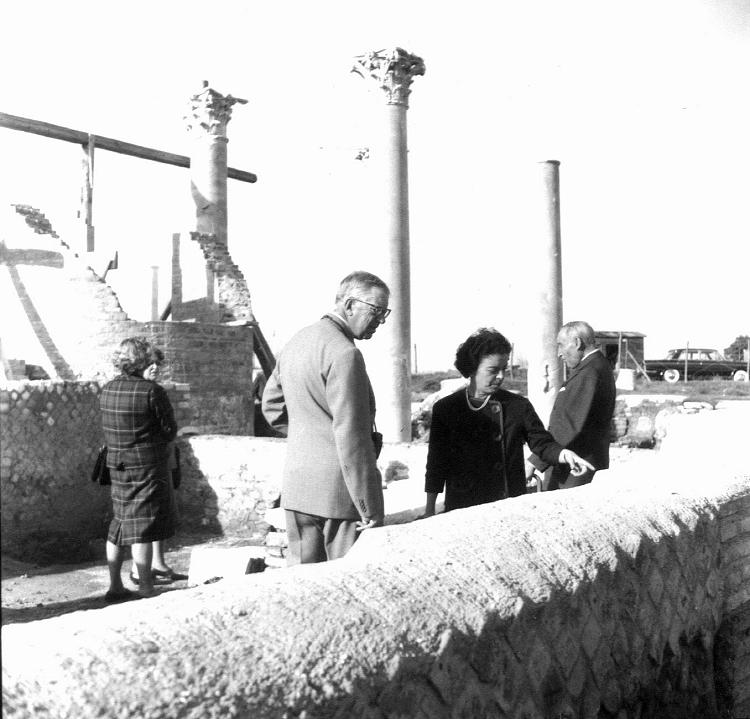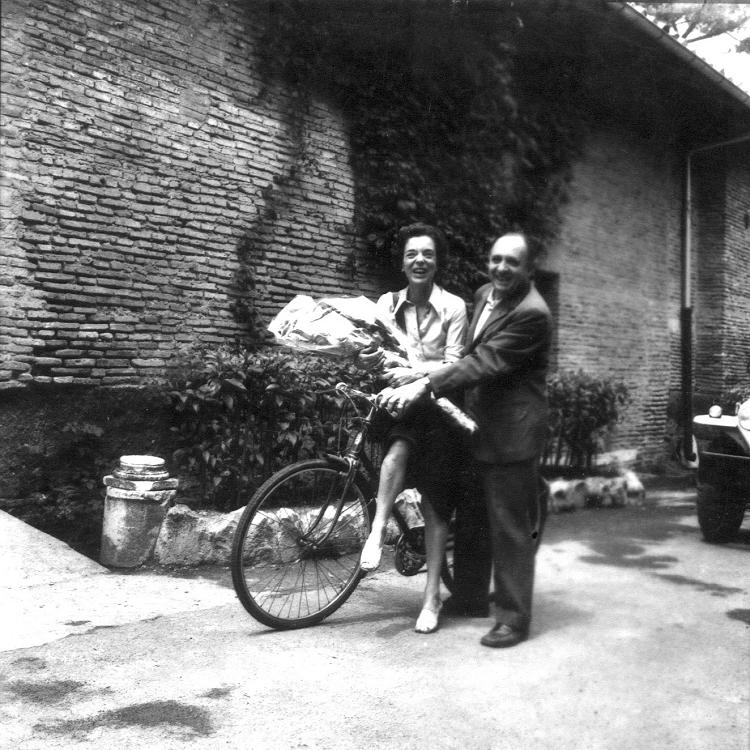Maria Floriani Squarciapino was the Inspector of Archaeology (from 1946 to 1966) and subsequently Superintendent of the Soprintendenza Archeologica di Ostia (from 1966 to 1974). The staff of the Soprintendenza wish to remember her to all of the "Ostiensi" and sends this text, as a gesture of great esteem and affection.
Elizabeth J. Shepherd
In Memoriam Maria Floriani Squarciapino (1917-2003)
As one of the more senior among the co-workers of Professor Maria Floriani Squarciapino in her university activity, the sad task, but also the honor, has fallen to me to commemorate her on behalf of the Pontifical Roman Academy of Archaeology, of which she was an illustrious member for a long time. I hope also to have succeeded in representing and interpreting the thoughts of other co-workers, colleagues, and of all those present.
At this moment, of grief and mourning, a time in which we all wish to be near her family offering further condolences, there comes also a moment of reflection, a moment afforded us to reconsider the meaning of a life. The life of an archeologist, of a woman of science, but for which she did not give up the role of mother, to her family, to friends, or to personal acquaintances. Her professional life did not suffocate the private one, nor vice versa. I do not know if the expression that I am about to use is correct and as respectful as I would wish: Maria Floriani Squarciapino was a very notable scholar who did not draw attention to herself, and who feigned not to be one. She was the Superintendent of Ostia, and as professor ordinarius at "La Sapienza;" she wrote (as we will see shortly) a large number of monographs and articles at a high level; she held offices and appointments in the Academies (such as this, the Pontifical Academy), in editorships (Fasti Archaeologici, varied works on the Treccani), in institutions of remarkable tradition (International Association of Classical Archaeology, Institute of Roman Studies), to recall only those cases of her greatest diligence. She never assumed the demeanor of a super-busy "career woman" (as we would call it today); she never avoided meetings with colleagues and students; she never came to them uninterested in everyday things. Nor did she overlook or ignore things of a personal nature, such as when she would caringly asked about one's children or family. Or when she recounted something about herself, she also talked occasionally about the very difficult times at the end of the war and of the grievous situations that resulted from it. Yet, she also spoke about her son Nando (or Fernando), who as a child played in the fields of Ostia Antica.
So, here we have Ostia - her direction of the Soprintendenza of Ostia may perhaps be taken as an illustration of her way of conceptualizing life: a monumental complex of incredible importance, in which both to invest one's energy, whether regarding its guardianship or its study, and to cultivate relations and to nourish collaborations. Tied to Ostia and to her Ostian research are several figures that had great relevance in Professor Squarciapino's life: her teacher Pietro Romanelli, her friends Italo Gismondi, Giovanni Becatti, Raissa Calza, Pasquale Testini, Guido Barbieri, Herbert Bloch, but also so many collaborators of subsequent generations that I cannot name them all. Her vision, shared with Becatti, ensures that one will have innovative experiences in Ostia, such as the excavation of Andrea Carandini in the Baths of the Swimmer (Terme del Nuotatore). The ancient city was (and luckily has remained to this day) a laboratory in which one is confronted with different approaches and methodologies. The close collaboration, often hoped for but not always systematically attained, between the Soprintendenza, Italian Universities, foreign institutes and scholars has been (and with luck is still) being widely achieved. The good relations established with the personnel of each order and rank created a certain "family feeling," a special climate.
Up till now we have outlined the profile of an ideal public servant. But it did not end here, and not only because this public servant was affiliated with the university. For Professor Squarciapino, Ostia was not only a site to protect and where all could work, but was also, obviously, an overarching subject in her personal research activity. From here we move on to trace, little by little, a unified picture of this research activity, which is very complex. As Fausto Zevi suggested on October 2, while taking part in her funeral ceremony in the church of San Lorenzo Fuori le Mura, it would be extremely opportune for the University "La Sapienza" to organize a colloquium on the subjects touched on by Professor Squarciapino that have grown in importance over the years. There often came to pass, as we all know, and as I have verified again in letters and reflections of those days, a peculiar situation: Professor Squarciapino identified (or contributed to identifying) subjects; she initiated (or contributed to the initiation of) discussions, by identifying fundamental directions in her extremely clear and exhaustive writings, while at the same time (in keeping with her usual style) she did this in a very simple and colloquial manner; she was never shown to be "jealous" of her arguments, she never placed a copyright on them, and therefore the paths opened by her have also been traveled by others, often by many others, until such time that these theories were proven to be of extraordinary importance. If the use of military terminology would not be out of place in these times, it could be said that Professor Squarciapino repeatedly lit the fuse (or contributed to it) for subjects that have since "exploded."
But what are these subjects? The main threads, besides Ostia, principally are two that I believe we do well to remember: Leptis Magna and Roman Africa; and Aphrodisias and the "School" of Aphrodisias. There may be others that if possible deserve some passing consideration, but which have become incredibly fruitful discoveries; we will speak of them later in the conclusion.
At Ostia, her work of greatest zeal (undertaken with the already mentioned friends Gismondi, Barbieri, Calza, and Bloch) was the publication (1958) of the necropolis dated primarily between the second century B.C. and the first century A.D. Besides the description and the commentary on the individual tombs, we also find in this volume an attentive examination of the superimposition and expansion of the sepulchral areas over time. Her volume (1962) on the oriental cults in the harbor town (Magna Mater, Mithras, Egyptian deities among who Isis and Serapis are distinct) was the third in the long series "Etudes préliminaires des réligions orientales dans l'Empire Romaine" conceived by Vermaseren and currently in its 149th volume. The study of the Synagogue, which is the most ancient in Europe (fourth century, but also with earlier phases), began with the publication of the introductory report in the Rendiconti of the Pontifical Academy in 1961-62, and led ultimately to a series of observations on possible classification of this type of monument, synthesized in the entry "Synagogue" in the Encyclopedia of Ancient Art.
In regard to Roman Africa, her most significant volume was that on the sculptures of the Severan Forum of Leptis Magna (1974): the reliefs with the Gigantomachy on the Temple of the Gens Septimia (already examined in the Rendiconti of the Pontifical Academy of 1954-56); the clipei with Medusa in the actual Piazza Forense; and the pilasters of the Basilica (those examined previously, to be precise, in the Archeologia Classica of 1958, with particular attention to the labors of Hercules cycle). All three are seen as components of a complex unitary whole, or it is better to say, conceived from a single mind, and executed by the sculptors of the School of Aphrodisias.
And here we come to the third "grand theme." The importance of this School (characterized by great technical skill of the sculptors who with pride signed their work declaring themselves "Aphrodisians") was brought to light by Professor Squarciapino in a volume from 1943. The excavations subsequently conducted in the city of Aphrodisias by K. T. Erim and by R. R. R. Smith, which are still in progress, supplied, and still are supplying, sensational confirmation of the absolute relevance of this artistic production, with the discovery of an incredible quantity of sculptures of high level, chronologically distributed across five centuries. So then in Archaeologia Classica of 1983 Professor Squarciapino (who in general did not like to return to arguments already treated) yielded to the temptation to present an article on "the School of Aphrodisias 40 years later," and it dwelt with particular attention on the reliefs of the Sebasteion or the sanctuary of the Augusti. On the two sides of the corridor that led to this sanctuary (which however we still do not know), three orders of colonnades produced three traceable series of depictions in three veins: mythical scenes, glorification of the imperial Julio-Claudian family, and personifications of subjugated peoples.
On a few occasions, Professor Squarciapino took an unusual path. Her old friendship with Paolo Matthiae and with the other excavators of Ebla had specific origins: in 1964, when Professor Squarciapino participated in the first explorations of the Mission to Syria. She contributed to the choice of the site of Tell Mardikh (and to say her choice was "prophetic" would be to say the least) and pointed out even then that the occupation of the site had been intermittent, with principal phases appearing to have arisen from the third millennium B.C. to the beginning of the second (the connection is published in Rendiconti of the Pontifical Academy of 1965-66). The enterprise has since experienced the good fortune that it deserved, and that we all know.
Finally, Merida, the ancient Augusta Emerita. At a conference held in 1974 (the proceedings were published in 1976) in the capital of the Roman province of Lusitania, Professor Squarciapino examined some relief fragments casually recovered (reemployed as a drain covers for a sewer channel) in the area of Pan Caliente north of the town, along the river Guadiana. Reliefs with Caryatids, clipei with Jupiter Ammon: it was a reprise, in the provincial environment, of subjects already treated in the Forum of Augustus in Rome; by necessity the pieces should have come from a considerable monument in a central area, like the clipei (similar, but not identical) recovered in another Iberian capital, Tarragona.
In more recent years, her hypothesis has been proven correct: at Merida the remains of the "Marble Forum" came to light with the presence, additionally, of another element taken again from the Forum of Augustus, the series of "Summi Viri" (characters of historical significance) dressed in togas.
So, this occasional work - so to speak - on the pieces recovered at Pan Caliente, the observations and the hypothesis advanced with the accustomed simplicity, even here were in some manner "prophetic," constituting a further example of her peculiar capacity to identify finds worthy of great developments. Here the developments point in two directions: on the one hand toward the intensification of research in the Iberian Peninsula, nearly unrestrained, in these last decades, magnificently illustrated in the 1997 exhibit Roman Hispania; on the other hand, toward the study of the urban monument to which these studies directly or indirectly lead back, or, better said, the "work in progress" in Rome in the Imperial Fora, which continues to span a long and extraordinary history.
Sergio Rinaldi Tufi
University of Urbino
[This translation of Prof. Tufi's memorial is offered as a token of esteem by Prof. Dr. L. Michael White, Director of the University of Texas Project on the Ostia Synagogue, in collaboration with his doctoral students, Dr. Susan Gelb and Dr. Douglas Boin, who also work on the Ostia Synagogue project. We too walk in the paths that Prof. Squarciapino helped to clear.]

